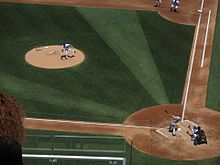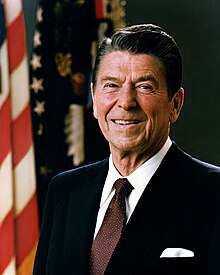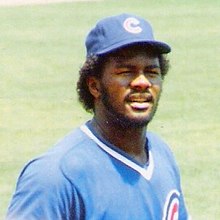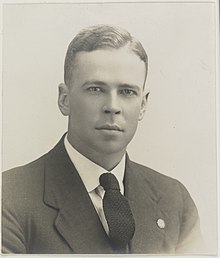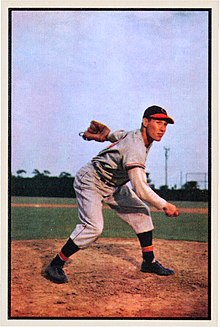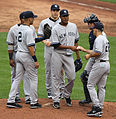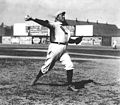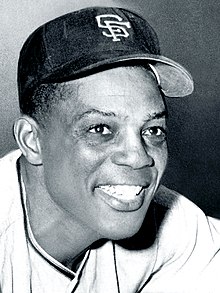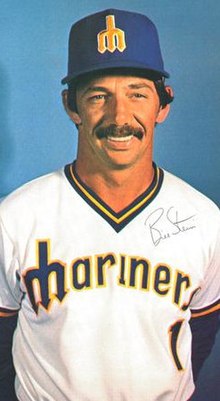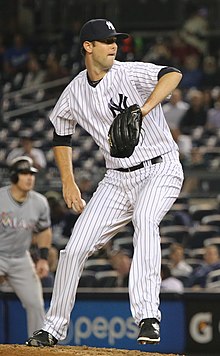Portal:Baseball
Portal maintenance status: (June 2018)
|
| Main page | Content, Categories & Topics | WikiProjects & Things you can do |
The Baseball Portal
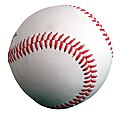
Baseball is a bat-and-ball sport played between two teams of nine players each, taking turns batting and fielding. The game occurs over the course of several plays, with each play generally beginning when a player on the fielding team, called the pitcher, throws a ball that a player on the batting team, called the batter, tries to hit with a bat. The objective of the offensive team (batting team) is to hit the ball into the field of play, away from the other team's players, allowing its players to run the bases, having them advance counter-clockwise around four bases to score what are called "runs". The objective of the defensive team (referred to as the fielding team) is to prevent batters from becoming runners, and to prevent runners advancing around the bases. A run is scored when a runner legally advances around the bases in order and touches home plate (the place where the player started as a batter).
The opposing teams switch back and forth between batting and fielding; the batting team's turn to bat is over once the fielding team records three outs. One turn batting for each team constitutes an inning. A game is usually composed of nine innings, and the team with the greater number of runs at the end of the game wins. Most games end after the ninth inning, but if scores are tied at that point, extra innings are usually played. Baseball has no game clock, though some competitions feature pace-of-play regulations such as the pitch clock to shorten game time.
Baseball evolved from older bat-and-ball games already being played in England by the mid-18th century. This game was brought by immigrants to North America, where the modern version developed. Baseball's American origins, as well as its reputation as a source of escapism during troubled points in American history such as the American Civil War and the Great Depression, have led the sport to receive the moniker of "America's Pastime"; since the late 19th century, it has been unofficially recognized as the national sport of the United States, though in modern times is considered less popular than other sports, such as American football. In addition to North America, baseball spread throughout the rest of the Americas and the Asia–Pacific in the 19th and 20th centuries, and is now considered the most popular sport in parts of Central and South America, the Caribbean, and East Asia, particularly in Japan, South Korea, and Taiwan. (Full article...)
 Featured articles - load new batch
Featured articles - load new batch
-
Image 1
Tyler Wayne Skaggs (July 13, 1991 – July 1, 2019) was an American left-handed professional baseball starting pitcher who played in Major League Baseball (MLB) for the Arizona Diamondbacks and Los Angeles Angels from 2012 until his death in 2019.
A native of Woodland Hills, California, and a graduate of Santa Monica High School, Skaggs was a supplemental first-round selection for the Angels in the 2009 Major League Baseball draft. He was traded to the Diamondbacks the following year as part of an exchange for pitcher Dan Haren and rose through Arizona's farm system. After two consecutive appearances at the All-Star Futures Game in 2011 and 2012, Skaggs made his major league debut on August 22, 2012, against the Miami Marlins. He remained with the Diamondbacks through the end of the season, but was optioned to the minor leagues in 2013. (Full article...) -
Image 2
Ronald Wilson Reagan (February 6, 1911 – June 5, 2004) was an American politician and actor who served as the 40th president of the United States from 1981 to 1989. He was a member of the Republican Party and became an important figure in the American conservative movement. His presidency is known as the Reagan era.
Born in Illinois, Reagan graduated from Eureka College in 1932 and was hired the next year as a sports broadcaster in Iowa. In 1937, he moved to California where he became a well-known film actor. During his acting career, Reagan was president of the Screen Actors Guild twice, from 1947 to 1952 and from 1959 to 1960. In the 1950s, he hosted General Electric Theater and worked as a motivational speaker for General Electric. Reagan's "A Time for Choosing" speech during the 1964 presidential election launched his rise as a leading conservative figure. After being elected governor of California in 1966, he raised state taxes, turned the state budget deficit into a surplus and implemented harsh crackdowns on university protests. Following his loss to Gerald Ford in the 1976 Republican Party presidential primaries, Reagan won the Republican Party's nomination and then a landslide victory over President Jimmy Carter in the 1980 presidential election. (Full article...) -
Image 3

Depiction of the game from The Boston Globe
On Saturday, May 1, 1920, the Brooklyn Dodgers and the Boston Braves played to a 1–1 tie in 26 innings, the most innings ever played in a single game in the history of Major League Baseball (MLB). The game was played at Braves Field in Boston before a crowd estimated at 4,000. Both Leon Cadore of Brooklyn and Joe Oeschger of Boston pitched complete games, and with 26 innings pitched, jointly hold the record for the longest pitching appearance in MLB history. Their record is considered unbreakable, as modern pitchers rarely pitch even nine innings, and newer baseball rules have made long extra-innings games a rarity.
The day of the game saw rainy weather, and it was uncertain if the game would be played, but the skies cleared enough to allow it to proceed. Brooklyn scored a run in the fifth inning, and Boston in the sixth; thereafter, the pitchers became increasingly dominant. As the game exceeded eighteen innings, the small crowd at Braves Field cheered both pitchers. The last twenty innings were scoreless, and when darkness started to fall, the umpires called a halt after the twenty-sixth inning, as baseball fields did not yet have artificial lighting. (Full article...) -
Image 4
James Howard Thome (/ˈtoʊmi/; TOH-mee; born August 27, 1970) is an American former professional baseball first baseman, third baseman and designated hitter, who played in Major League Baseball (MLB) for 22 seasons (1991–2012). A prolific power hitter, Thome hit 612 home runs during his career—the eighth-most all time. He amassed a total of 2,328 hits and 1,699 runs batted in (RBIs). His career batting average was .276. He was a member of five All-Star teams and won a Silver Slugger Award in 1996.
Thome grew up in Peoria, Illinois, as part of a large blue-collar family of athletes, who predominantly played baseball and basketball. After attending Illinois Central College, he was drafted by the Indians in the 1989 draft, and made his big league debut in 1991. Early in his career, Thome played third base, before eventually becoming a first baseman. With the Indians, he was part of a core of players that led the franchise to five consecutive playoff appearances in the 1990s, including World Series appearances in 1995 and 1997. Thome spent over a decade with Cleveland, before leaving via free agency after the 2002 season, to join the Philadelphia Phillies, with whom he spent the following three seasons. Traded to the Chicago White Sox before the 2006 season, he won the American League (AL) Comeback Player of the Year Award that year and joined the 500 home run club during his three-season tenure with the White Sox. By this point in his career, back pain limited Thome to being a designated hitter. After stints with the Los Angeles Dodgers and Minnesota Twins, he made brief returns to Cleveland and Philadelphia, before ending his career with the Baltimore Orioles. Upon retiring, Thome accepted an executive position with the White Sox. (Full article...) -
Image 5
James Francis Thorpe (Meskwaki: Wa-Tho-Huk, May 22 or 28, 1887 – March 28, 1953) was an American athlete and Olympic gold medalist. A citizen of the Sac and Fox Nation, Thorpe was the first Native American to win a gold medal for the United States in the Olympics. Considered one of the most versatile athletes of modern sports, he won two Olympic gold medals in the 1912 Summer Olympics (one in classic pentathlon and the other in decathlon). He also played football (collegiate and professional), professional baseball, and professional basketball.
He lost his Olympic titles after it was found he had been paid for playing two seasons of semi-professional baseball before competing in the Olympics, thus violating the contemporary amateurism rules. In 1983, 30 years after his death, the International Olympic Committee (IOC) restored his Olympic medals with replicas, after ruling that the decision to strip him of his medals fell outside of the required 30 days. Official IOC records still listed Thorpe as co-champion in decathlon and pentathlon until 2022, when it was decided to restore him as the sole champion in both events. (Full article...) -
Image 6
Lee Arthur Smith (born December 4, 1957) is an American former professional baseball pitcher who played 18 years in Major League Baseball (MLB) for eight teams. Serving mostly as a relief pitcher during his career, he was a dominant closer, was the first pitcher to reach 400 saves, and held the major league record for career saves from 1993 until 2006, when Trevor Hoffman passed his total of 478. He was elected to the National Baseball Hall of Fame as part of the class of 2019 by the Today's Game Era Committee.
A native of Jamestown in Bienville Parish in north Louisiana, Smith was scouted by Buck O'Neil and was selected by the Chicago Cubs in the 1975 MLB draft. Smith was an intimidating figure on the pitcher's mound at 6 feet 6 inches (1.98 m) and 265 pounds (120 kg) with a 95-mile-per-hour (150 km/h) fastball. In 1991, he set a National League (NL) record with 47 saves for the St. Louis Cardinals, and was runner-up for the league's Cy Young Award; it was the second of three times Smith led the NL in saves, and he later led the American League (AL) in saves once. When he retired, he held the major league record for career games finished (802) and was third in games pitched (1,022). He holds the Cubs' team record for career saves (180), and held the same record for the Cardinals (160) until 2006. (Full article...) -
Image 7

Ian Michael Chappell (born 26 September 1943) is a former cricketer who played for South Australia and Australia. Known as "Chappelli", he is considered as one of the greatest captains the game has seen. He captained Australia between 1971 and 1975 before taking a central role in the breakaway World Series Cricket organisation. Born into a cricketing family—his grandfather and brother also captained Australia—Chappell made a hesitant start to international cricket playing as a right-hand middle-order batsman and spin bowler. He found his niche when promoted to bat at number three. Chappell's blunt verbal manner led to a series of confrontations with opposition players and cricket administrators; the issue of sledging first arose during his tenure as captain, and he was a driving force behind the professionalisation of Australian cricket in the 1970s. He was the captain of the Australian squad which finished as runners-up at the 1975 Cricket World Cup.
John Arlott called him "a cricketer of effect rather than the graces". An animated presence at the batting crease, he constantly adjusted his equipment and clothing, and restlessly tapped his bat on the ground as the bowler ran in. Basing his game on a sound defence learned during many hours of childhood lessons, Chappell employed the drive and square cut to full effect. He had an idiosyncratic method of playing back and across to a ball of full length and driving wide of mid-on, but his trademark shot was the hook, saying "three bouncers an over should be worth 12 runs to me". A specialist slip fielder, he was the fourth player to take one hundred Test catches. (Full article...) -
Image 8
William Harold Ponsford MBE (19 October 1900 – 6 April 1991) was an Australian cricketer. Usually playing as an opening batsman, he formed a successful and long-lived partnership opening the batting for Victoria and Australia with Bill Woodfull, his friend and state and national captain. Ponsford is the only player to twice break the world record for the highest individual score in first-class cricket; Ponsford and Brian Lara are the only cricketers to twice score 400 runs in an innings. Ponsford holds the Australian record for a partnership in Test cricket, set in 1934 in combination with Don Bradman (451 for 2nd wicket)—the man who broke many of Ponsford's other individual records. In fact, he along with Bradman set the record for the highest partnership ever for any wicket in Test cricket history when playing on away soil (451 runs for the second wicket)
Despite being heavily built, Ponsford was quick on his feet and renowned as one of the finest ever players of spin bowling. His bat, much heavier than the norm and nicknamed "Big Bertha", allowed him to drive powerfully and he possessed a strong cut shot. However, critics questioned his ability against fast bowling, and the hostile short-pitched English bowling in the Bodyline series of 1932–33 was a contributing factor in his early retirement from cricket a year and a half later. Ponsford also represented his state and country in baseball, and credited the sport with improving his cricketing skills. (Full article...) -
Image 9The Nashville Sounds Minor League Baseball team was established in Nashville, Tennessee, in 1978, after Larry Schmittou and a group of investors purchased the rights to operate an expansion franchise of the Double-A Southern League. The Sounds played their home games at Herschel Greer Stadium from its opening in 1978 until the end of the 2014 season. In 2015, the Sounds left Greer for First Tennessee Park, now known as First Horizon Park, a new facility located on the site of the historic Sulphur Dell ballpark, home to Nashville's minor league teams from 1885 to 1963.
The Sounds led all of Minor League Baseball in attendance in their inaugural season and continued to draw the Southern League's largest crowds in each of their seven years as members of the league. On the field, the team won six consecutive second-half division titles from 1979 to 1984 and won the Southern League championship twice: in 1979 as the Double-A affiliate of the Cincinnati Reds and again in 1982 as the Double-A affiliate of the New York Yankees. (Full article...) -
Image 10
Stanley Frank Musial (/ˈmjuːziəl, -ʒəl/; born Stanislaw Franciszek Musial; November 21, 1920 – January 19, 2013), nicknamed "Stan the Man", was an American baseball outfielder and first baseman. Widely considered to be one of the greatest and most consistent hitters in baseball history, Musial spent 22 seasons in Major League Baseball (MLB), playing for the St. Louis Cardinals, from 1941 to 1944 and from 1946 to 1963. He was inducted into the Baseball Hall of Fame in 1969 in his first year of eligibility.
Musial was born in Donora, Pennsylvania, where he frequently played baseball informally or in organized settings, and eventually played on the baseball team at Donora High School. Signed to a professional contract by the St. Louis Cardinals as a pitcher in 1938, Musial was converted into an outfielder and made his major league debut in 1941. Noted for his unique batting stance, he quickly established himself as a consistent and productive hitter. In his first full season, 1942, the Cardinals won the World Series. The following year, he led the NL in six different offensive categories and earned his first MVP award. He was also named to the NL All-Star squad for the first time; he appeared in every All-Star game in every subsequent season he played. Musial won his second World Series championship in 1944, then missed the 1945 season while serving in the Navy. After completing his military service, Musial returned to baseball in 1946 and resumed his consistent hitting. That year he earned his second MVP award and third World Series title. His third MVP award came in 1948, when he finished one home run short of winning baseball's Triple Crown. After struggling offensively in 1959, Musial used a personal trainer to help maintain his productivity until he decided to retire in 1963. (Full article...) -
Image 11Disco Demolition Night was a Major League Baseball (MLB) promotion on Thursday, July 12, 1979, at Comiskey Park in Chicago, Illinois, that ended in a riot. At the climax of the event, a crate filled with disco records was blown up on the field between games of the twi-night doubleheader between the Chicago White Sox and the Detroit Tigers. Many had come to see the explosion rather than the games and rushed onto the field after the detonation. The playing field was so damaged by the explosion and by the rioters that the White Sox were required to forfeit the second game to the Tigers.
In the late 1970s, dance-oriented disco was the most popular music genre in the United States, particularly after being featured in hit films such as Saturday Night Fever (1977). However, disco sparked a major backlash from rock music fans—an opposition prominent enough that the White Sox, seeking to fill seats at Comiskey Park during a lackluster season, engaged Chicago shock jock and anti-disco campaigner Steve Dahl for the promotion at the July 12 doubleheader. Dahl's sponsoring radio station was WLUP (97.9 FM, now WCKL), so admission was discounted to 98 cents for attendees who turned in a disco record; between games, Dahl was to destroy the collected vinyl in an explosion. (Full article...) -
Image 12

WSNS-TV (channel 44) is a television station in Chicago, Illinois, United States, serving as the local outlet for the Spanish-language network Telemundo. It is owned and operated by NBCUniversal's Telemundo Station Group alongside NBC outlet WMAQ-TV (channel 5). The two stations share studios at the NBC Tower on North Columbus Drive in the city's Streeterville neighborhood and broadcast from the same transmitter atop the Willis Tower in the Chicago Loop.
WSNS-TV began broadcasting in 1970. Originally specializing in the automated display of news headlines, it evolved into Chicago's third full-fledged independent station, carrying movies, local sports, and other specialty programming. This continued until 1980, when WSNS became the Chicago-area station for ON TV, an over-the-air subscription television (STV) service owned by Oak Industries, which took a minority ownership stake in the station. While ON TV was successful in Chicago and the subscription system became the second-largest in the country by total subscribers, the rise of cable television precipitated the end of the business in 1985, with WSNS-TV as the last ON TV station standing. (Full article...) -
Image 13
Osborne Earl Smith (born December 26, 1954) is an American former professional baseball player. Nicknamed "The Wizard of Oz", Smith played shortstop for the San Diego Padres and St. Louis Cardinals in Major League Baseball, winning the National League Gold Glove Award for defensive play at shortstop for 13 consecutive seasons. A 15-time All-Star, Smith accumulated 2,460 hits and 580 stolen bases during his career, and won the National League Silver Slugger Award as the best hitter at shortstop in 1987. He was elected to the Baseball Hall of Fame in his first year of eligibility in 2002. He was also elected to the St. Louis Cardinals Hall of Fame in the inaugural class of 2014.
Smith was born in Mobile, Alabama; his family moved to Watts, Los Angeles, when he was six years old. While participating in childhood athletic activities, Smith possessed quick reflexes; he went on to play baseball at Locke High School in Los Angeles, then at California Polytechnic State University, San Luis Obispo. Drafted as an amateur player by the Padres, Smith made his major league debut in 1978. He quickly established himself as an outstanding fielder, and later became known for performing backflips on special occasions while taking his position at the beginning of a game. Smith won his first Gold Glove Award in 1980 and made his first All-Star Game appearance in 1981. (Full article...) -
Image 14
Robert William Andrew Feller (November 3, 1918 – December 15, 2010), nicknamed "the Heater from Van Meter", "Bullet Bob", and "Rapid Robert", was an American baseball pitcher who played 18 seasons in Major League Baseball (MLB) for the Cleveland Indians between 1936 and 1956. In a career spanning 570 games, Feller pitched 3,827 innings and posted a win–loss record of 266–162, with 279 complete games, 44 shutouts, and a 3.25 earned run average (ERA). His career 2,581 strikeouts were third all-time upon his retirement.
A prodigy who bypassed baseball's minor leagues, Feller made his debut with the Indians at the age of 17. His career was interrupted by four years of military service (1942–1945) as a United States Navy Chief Petty Officer aboard USS Alabama during World War II. Feller became the first pitcher to win 24 games in a season before the age of 21. He threw no-hitters in 1940, 1946, and 1951, and 12 one-hitters, both records at his retirement. He helped the Indians win a World Series title in 1948 and an American League-record 111 wins and the pennant in 1954. Feller led the American League in wins six times and in strikeouts seven times. In 1946 he recorded 348 strikeouts, the most since 1904 and then believed to be a record. (Full article...) -
Image 15William Derrick Bates (born December 7, 1963) is an American former professional baseball second baseman and pinch runner who played in Major League Baseball (MLB) for the Milwaukee Brewers and the Cincinnati Reds. In 29 career games, Bates had a batting average of .125 with six hits, two runs batted in (RBI), 11 runs, and eight stolen bases. Though his defensive position was at second base, the Reds primarily used Bates as a pinch runner. After he scored the winning run in Game 2 of the 1990 World Series, Bates never played in MLB again.
Born in Houston, Bates attended the University of Texas and, in his freshman season, won the 1983 College World Series as a part of the Texas Longhorns baseball team. For the next two seasons, Bates was named to the College Baseball All-America Team, a team composed of the best collegiate baseball athletes in America. Drafted by Milwaukee in the fourth round of the 1985 MLB draft, he rose through the Brewers' farm system helping several of his minor league teams win their respective league titles. He made his MLB debut in 1989, after Milwaukee's starting second baseman Jim Gantner was injured. A trade in 1990 sent Bates to Cincinnati, where the Reds used him primarily as a pinch runner at the end of the regular season and into the postseason. Facing the Oakland Athletics in the World Series, Bates reached base on a pinch hit single against Dennis Eckersley and later scored the winning run in Game 2 as the Reds swept the Athletics four games to none. Following the World Series championship, the Reds re-signed Bates on a one-year contract, and he played for their Triple-A team. He spent the next year with the Chicago Cubs Triple-A affiliate, and last played exhibition baseball in 1995. After retiring, he worked as an equipment supplier in the oil and gas industry in Houston. (Full article...)
General images - load new batch
-
Image 2Pitchers are generally substituted during mound visits (team gatherings at the pitcher's mound). (from Baseball rules)
-
Image 3Sadaharu Oh managing the Japan national team in the 2006 World Baseball Classic. Playing for the Central League's Yomiuri Giants (1959–80), Oh set the professional world record for home runs. (from Baseball)
-
Image 5Rickey Henderson—the major leagues' all-time leader in runs and stolen bases—stealing third base in a 1988 game (from Baseball)
-
Image 6The NL champion New York Giants baseball team, 1913. Fred Merkle, sixth in line, had committed a baserunning gaffe in a crucial 1908 game that became famous as Merkle's Boner. (from History of baseball)
-
Image 8A pitcher handing off the ball after being taken out of the game during a mound meeting. (from Baseball)
-
Image 9The American Tobacco Company's line of baseball cards featured shortstop Honus Wagner of the Pittsburgh Pirates from 1909 to 1911. In 2007, the card shown here sold for $2.8 million. (from Baseball)
-
Image 11Diagram of a baseball field Diamond may refer to the square area defined by the four bases or to the entire playing field. The dimensions given are for professional and professional-style games. Children often play on smaller fields. (from Baseball)
-
Image 12A New York Yankees batter (Andruw Jones) and a Boston Red Sox catcher at Fenway Park (from Baseball)
-
Image 14The strike zone determines the result of most pitches, and varies in vertical length for each batter. (from Baseball)
-
Image 15Cover of Official Base Ball Rules, 1921 edition, used by the American League and National League (from Baseball rules)
-
Image 17In May 2010, the Philadelphia Phillies' Roy Halladay pitched the 20th major league perfect game. That October, he pitched only the second no-hitter in MLB postseason history. (from History of baseball)
-
Image 18An Afghan girl playing baseball in August 2002 (from Baseball)
-
Image 19The strike zone, which determines the outcome of most pitches, varies in vertical length depending on the batter's typical height while swinging. (from Baseball rules)
-
Image 20Pesäpallo, a Finnish variation of baseball, was invented by Lauri "Tahko" Pihkala in the 1920s, and after that, it has changed with the times and grown in popularity. Picture of Pesäpallo match in 1958 in Jyväskylä, Finland. (from Baseball)
-
Image 21Jackie Robinson in 1945, with the era's Kansas City Royals, a barnstorming squad associated with the Negro American League's Kansas City Monarchs (from History of baseball)
-
Image 22A first baseman receives a pickoff throw, as the runner dives back to first base. (from Baseball)
-
Image 23A well-worn baseball (from Baseball)
-
Image 24By the 1860s Civil War, baseball (bottom) had overtaken its fellow bat-and-ball sport cricket (top) in popularity within the United States. (from History of baseball)
-
Image 25Diagram indicating the standard layot of positions (from Baseball)
-
Image 262013 World Baseball Classic championship match between the Dominican Republic and Puerto Rico, March 20, 2013 (from Baseball)
-
Image 271906 World Series, infielders playing "in" for the expected bunt and the possible play at the plate with the bases loaded (from Baseball rules)
-
Image 28A runner sliding into home plate and scoring. (from Baseball)
-
Image 29The typical motion of a right-handed pitcher (from Baseball rules)
-
Image 30Japanese-Americans spectating a World War II-era game while in an internment camp. America's ties to immigrants and to Japan have been deeply shaped by a shared baseball heritage. (from History of baseball)
-
Image 31Sadaharu Oh managing the Japan national team in the 2006 World Baseball Classic. Playing for the Central League's Yomiuri Giants (1959–80), Oh set the professional world record for home runs with 868. (from History of baseball)
-
Image 33Jackie Robinson in 1945, with the era's Kansas City Royals, a barnstorming squad associated with the Negro American League's Kansas City Monarchs (from Baseball)
-
Image 34The standard fielding positions (from Baseball rules)
-
Image 35Baseball games sometimes end in a walk-off home run, with the batting team usually gathering at home plate to celebrate the scoring of the winning run(s). (from Baseball rules)
-
Image 38Baserunners generally stand a short distance away from their base between pitches, preparing themselves to either go back or steal the next base. (from Baseball rules)
-
Image 39A batter follows through after swinging at a pitched ball. (from Baseball rules)
-
Image 40A game from the Cantigas de Santa Maria, c. 1280, involving tossing a ball, hitting it with a stick and competing with others to catch it (from History of baseball)
-
Image 42Fenway Park, home of the Boston Red Sox. The Green Monster is visible beyond the playing field on the left. (from Baseball)
-
Image 43Cy Young—the holder of many major league career marks, including wins and innings pitched, as well as losses—in 1908. MLB's annual awards for the best pitcher in each league are named for Young. (from Baseball)
-
Image 44Pick-off attempt on runner (in red) at first base (from Baseball rules)
-
Image 45Alexander Cartwright, father of modern baseball (from History of baseball)
 Good articles - load new batch
Good articles - load new batch
-
Image 1
Willie Howard Mays Jr. (May 6, 1931 – June 18, 2024), nicknamed "the Say Hey Kid", was an American professional baseball center fielder who played 23 seasons in Major League Baseball (MLB). Widely regarded as one of the greatest players of all time, Mays was a five-tool player who began his career in the Negro leagues, playing for the Birmingham Black Barons, and spent the rest of his career in the National League (NL), playing for the New York / San Francisco Giants and New York Mets.
Born in Westfield, Alabama, Mays was an all-around athlete. He joined the Black Barons of the Negro American League in 1948, playing with them until the Giants signed him upon his graduation from high school in 1950. He debuted in MLB with the Giants and won the Rookie of the Year Award in 1951 after hitting 20 home runs to help the Giants win their first pennant in 14 years. In 1954, he won the NL Most Valuable Player (MVP) Award, leading the Giants to their last World Series title before their move to the West Coast. His over-the-shoulder catch in Game 1 of the 1954 World Series is one of the most famous baseball plays of all time. After the Giants moved to San Francisco, Mays went on to win another MVP Award in 1965 and also led the Giants to the 1962 World Series, this time losing to the New York Yankees. He ended his career with a return to New York after an early season trade to the New York Mets in 1972, retiring after the team's trip to the 1973 World Series. He served as a coach for the Mets for the rest of the decade before rejoining the Giants as a special assistant to the president and general manager. (Full article...) -
Image 2Raymond Harvey (3 January 1926 – 6 January 2011) was an Australian former first-class cricketer who played for Victoria in the 1940s and 1950s. He was the brother of Australian Test batsmen Merv and Neil and first-class cricketer and umpire Mick Harvey. Ray Harvey was an attacking and talented batsman but failed to reach international standards and only managed to hold down a regular position in the Victorian team in two seasons in the 1950s. This failure to match the standards set by his Test-capped brothers was often attributed to a lack of single-mindedness and hunger.
Harvey was born into a working-class, devoutly Methodist family. His father was a keen amateur cricketer and an instilled a love of the game in his six sons, all of whom played for Fitzroy in Victorian Premier Cricket. Harvey made his first class debut in the middle of the 1947–48 season, and played his first two matches for Victoria alongside his more decorated brothers Merv and Neil. However, he performed poorly and did not play a match in the following summer and for the two subsequent seasons, he played in only three games but contributed little to his team's cause. In 1951–52 he made five appearances, gaining selection only when Victoria's Test players were busy representing Australia. The following season, he gained selection for the last three matches and broke through for his maiden first-class century, having never previously passed 50. (Full article...) -
Image 3
The Mets–Willets Point station is a rapid transit station on the IRT Flushing Line of the New York City Subway. Located near the Citi Field baseball stadium, it is served by the 7 train at all times and by the express <7> train during rush hours in the peak direction or after sporting events. This station is located near Flushing Meadows–Corona Park in Willets Point, Queens, on Roosevelt Avenue between 114th and 126th Streets.
The station opened on May 7, 1927, as a local station named Willets Point Boulevard, with two side platforms and three tracks. It was rebuilt into the current layout of three tracks, two side platforms, and a center island platform for the 1939 New York World's Fair. The overpass to Flushing Meadows–Corona Park was rebuilt in the early 1940s. Ahead of the 1964 New York World's Fair, the original wooden platforms were replaced with more durable concrete slabs. Shortly afterward, the station was renamed Willets Point–Shea Stadium for the nearby baseball stadium. After Shea Stadium was replaced by Citi Field in 2009, the station was renamed after the New York Mets baseball team, and a ramp was added to the Flushing-bound side platform. A connection to the proposed AirTrain LaGuardia people mover system was announced in 2015, but the people mover was canceled in 2023. (Full article...) -
Image 4
William Allen Stein (born January 21, 1947) is an American former professional baseball player and manager. His playing career spanned 17 seasons, 14 of which were spent in Major League Baseball (MLB) with the St. Louis Cardinals (1972–1973), the Chicago White Sox (1974–1976), the Seattle Mariners (1977–1980), and the Texas Rangers (1981–1985). Over his career in the majors Stein batted .267 with 122 doubles, 18 triples, 44 home runs, and 311 runs batted in (RBIs) in 959 games played. Stein played numerous fielding positions over his major league career, including third base, second base, first base, left field, right field, and shortstop. He also spent significant time as a pinch hitter. (Full article...) -
Image 5
Ian Patrick Kennedy (born December 19, 1984) is an American former professional baseball pitcher. Between 2007 and 2023, he played 17 seasons in Major League Baseball (MLB) for the New York Yankees, Arizona Diamondbacks, San Diego Padres, Kansas City Royals, Texas Rangers, and Philadelphia Phillies.
A standout pitcher at La Quinta High School in California, Kennedy played three seasons of college baseball for the USC Trojans. The Yankees selected him 21st overall in the 2006 MLB Draft and he quickly rose through the team's farm system, making his major league debut the next year. The Yankees traded Kennedy to the Diamondbacks after the 2009 season, and he became Arizona's ace, leading the National League in wins during the 2011 season. (Full article...) -
Image 6

Oscar E. "Reddy" Foster (August 1864 – December 19, 1908) was a Major League Baseball (MLB) player for the New York Giants in 1896. His only MLB appearance was on June 3 of that season. He primarily played catcher in his minor league career, which spanned 17 seasons. Foster was a manager as well. He was known for his fiery temper and his heavy drinking. Foster died on December 19, 1908, when he deliberately shot himself in the head with a shotgun. (Full article...) -
Image 7The 1959 National League tie-breaker series was a best-of-three playoff series that extended Major League Baseball's (MLB) 1959 regular season to decide the winner of the National League (NL) pennant. The tiebreaker series was necessary after the Los Angeles Dodgers and Milwaukee Braves finished the season with identical win–loss records of 86–68 (.558) on Sunday, September 27, three games ahead of the San Francisco Giants. It was the first tie-breaker in the majors in eight years, also in the National League.
The tie-breaker games were played on September 28 and 29. All the games were scheduled as day games, the opener on Monday was at Milwaukee County Stadium and the second on Tuesday at Los Angeles Memorial Coliseum.
The Dodgers won a coin flip late in the season that gave them home field advantage for the series (games two and three). If needed, the third game was scheduled for Wednesday, September 30. The Dodgers had hoped for night games in Los Angeles to take advantage of the Coliseum's seating capacity. The series was broadcast nationally by ABC television, with George Kell and Bob DeLaney announcing, and ABC radio, with Bob Finnegan and Tony Flynn announcing. (Full article...) -
Image 8Collins with the St. Louis Browns, 1922
Tharon Leslie "Pat" Collins (September 13, 1896 – May 20, 1960) was an American baseball catcher who played ten seasons in Major League Baseball (MLB). He played for the St. Louis Browns, New York Yankees and Boston Braves from 1919 to 1929. Collins batted and threw right-handed and also played five games at first base.
Collins played minor league baseball for the Joplin Miners until 1919, when he signed with the Browns. After spending six seasons with the organization, Collins spent a one-year sojourn in the minor leagues before he was traded to the Yankees, where he spent the next three years and played in the famous 1927 Murderers' Row lineup. At the conclusion of the 1928 season, he was traded to the Braves, with whom he played his last major league game on May 23, 1929. A two-time World Series champion, he is famous for being the only major league player to pinch hit and pinch run in the same game. (Full article...) -
Image 9
Robert Gibson (November 9, 1935 – October 2, 2020), nicknamed "Gibby" and "Hoot", was an American baseball pitcher in Major League Baseball who played his entire career for the St. Louis Cardinals from 1959 to 1975. Known for his fiercely competitive nature, Gibson tallied 251 wins, 3,117 strikeouts, and a 2.91 earned run average. A nine-time All-Star and two-time World Series Champion, he won two Cy Young Awards and the 1968 National League Most Valuable Player Award.
Born in Omaha, Nebraska, Gibson overcame childhood illness to excel in youth sports, particularly basketball and baseball. After briefly playing with the Harlem Globetrotters basketball team, he chose to pursue baseball and signed with the St. Louis Cardinals organization. He became a full-time starting pitcher in July 1961 and earned his first All-Star appearance in 1962. Gibson won 2 of 3 games he pitched in the 1964 World Series, then won 20 games in a season for the first time in 1965. Gibson also pitched three complete game victories in the 1967 World Series. He is one of four players and two pitchers to win multiple World Series MVPs. (Full article...) -
Image 10Walter Francis O'Malley (October 9, 1903 – August 9, 1979) was an American sports executive who owned the Brooklyn / Los Angeles Dodgers team in Major League Baseball from 1950 to 1979. In 1958, as owner of the Dodgers, he brought major league baseball to the West Coast, moving the Dodgers from Brooklyn to Los Angeles despite the Dodgers being the second most profitable team in baseball from 1946 to 1956, and coordinating the move of the New York Giants to San Francisco at a time when there were no teams west of Kansas City, Missouri. In 2008, O'Malley was elected to the National Baseball Hall of Fame for his contributions to and influence on the game of baseball.
O'Malley's father, Edwin Joseph O'Malley, was politically connected. Walter, a University of Pennsylvania salutatorian, went on to obtain a Bachelor of Laws (LL.B.), and he used the combination of his family connections, his personal contacts, and both his educational and vocational skills to rise to prominence. First, he became an entrepreneur involved in public works contracting, and then he became an executive with the Dodgers. He progressed from being a team lawyer to being both the Dodgers' owner and president, and he eventually made the business decision to relocate the Dodgers franchise. Although he moved the franchise, O'Malley is known as a businessman whose major philosophy was stability through loyalty to and from his employees. (Full article...) -
Image 11
Ryan Francis Garko (born January 2, 1981) is an American former professional baseball outfielder, first baseman, and designated hitter. In college, he was a catcher. He played in Major League Baseball (MLB) for the Cleveland Indians, San Francisco Giants, and Texas Rangers, as well as in the KBO League for the Samsung Lions. Garko was seen by former ESPN reporter John Sickels as a good hitter who hit to all parts of the field, but with poor defensive instincts. He had a .275 batting average, 427 hits, 55 home runs, and 250 RBI in 463 career games.
When he attended Stanford University, Garko won the Johnny Bench Award and was named the Pac-10 Co-Player of the Year his senior year. He was also voted onto the College World Series Legends Team, featuring 28 of the best College World Series players as voted upon by fans, writers, and head coaches. During his time in the Cleveland Indians' organization, Garko was converted into a first baseman. In 2006, Baseball America ranked him as the fifth-best prospect in the Indians organization, including being the best at hitting for average. (Full article...) -
Image 12

John Milton Warhop (July 4, 1884 – October 4, 1960) was an American baseball pitcher who played eight seasons in Major League Baseball (MLB) from 1908 to 1915 for the New York Highlanders / Yankees.
Considered by baseball insiders and historians as an unlucky pitcher, Warhop had a career 69–92 win–loss record, but with a 3.12 earned run average while playing for mostly second division Highlanders/Yankees teams. Of his 92 losses, the Yankees did not score a run in 23, and he holds the MLB record for losing the most 1–0 games with five in 1914. In 1915, Warhop allowed Babe Ruth's first two career home runs. He was released after the 1915 season and played a number of seasons in minor league baseball and semi-professional teams until his late 40s or early 50s. (Full article...) -
Image 13

Joe Luther Hall Jr. (born November 3, 1979) is an American football administrator, coach, and former fullback / running back who is currently the director of football student-athlete development for the Kansas State Wildcats. After attending Artesia High School in California, he played college football at Palomar College and Kansas State, leading the former to the national junior college championship as a sophomore. At Kansas State, Hall spent three seasons, redshirting one, being described at over 300 pounds "the largest running back to ever rush for 100 yards in an NCAA game" by Sports Illustrated. Following his time at Kansas State, he spent several seasons in the National Football League (NFL) with the St. Louis Rams, Kansas City Chiefs, and Oakland Raiders as well as in NFL Europe with the Rhein Fire. (Full article...) -
Image 14
Charles Leo "Gabby" Hartnett (December 20, 1900 – December 20, 1972), also nicknamed "Old Tomato Face", was an American professional baseball player and manager. He played almost his entire career in Major League Baseball as a catcher with the Chicago Cubs, from 1922 to 1940. He spent the final season of his career as a player-coach with the New York Giants in 1941. After his playing career, Hartnett continued his involvement in baseball as a coach and as a minor league manager.
Hartnett was an all-around player, performing well both offensively and defensively. Known for his strong and accurate throwing arm, he routinely led the National League's catchers in caught stealing percentage and was the first major league catcher to hit more than 20 home runs in a season. During the course of his career, Hartnett took part in some of the more memorable events in Major League Baseball history including: being behind the plate for Babe Ruth allegedly calling his shot during the 1932 World Series, Carl Hubbell's strike-out performance in the 1934 All-Star Game and Dizzy Dean's career-altering injury during the 1937 All-Star Game. However, the greatest moment of Hartnett's career came with one week left in the 1938 season, when he hit a game-winning home run in the bottom of the ninth inning to put the Cubs in first place. The event, which occurred as darkness descended onto Wrigley Field, became immortalized as the "Homer in the Gloamin'". (Full article...) -
Image 15Martin with the New York Yankees in 2015
Christopher Riley Martin (born June 2, 1986) is an American professional baseball pitcher for the Texas Rangers of Major League Baseball (MLB). He has previously played in MLB for the Colorado Rockies, New York Yankees, Atlanta Braves, Chicago Cubs, Los Angeles Dodgers, Boston Red Sox, and in Nippon Professional Baseball (NPB) for the Hokkaido Nippon-Ham Fighters.
Martin played baseball at Arlington High School and McLennan Community College, but gave up on baseball after he suffered a shoulder injury. After working in a warehouse for three years, Martin began playing catch, and felt strong enough to try out for independent league baseball. After he pitched for the Grand Prairie AirHogs in 2010, the Boston Red Sox of MLB signed Martin in 2011. He pitched in Minor League Baseball for the Red Sox organization, until they traded him to the Rockies after the 2013 season. (Full article...)
Did you know (auto-generated) - load new batch

- ... that after the 1918 season, some Major League Baseball owners wanted the National Baseball Commission to be replaced by former president William Howard Taft?
- ... that Tom Urbani was an original Dirtbag?
- ... that Devin Futrell used a post to dodge a draft?
- ... that Major League Baseball player Wade Meckler was 4 feet 10 inches (1.47 metres) tall and weighed 75 pounds (34 kilograms) when he was a high-school freshman?
- ... that doctors told Lance McCullers that he should not continue to pitch in 1990, but he returned to Major League Baseball in 1992?
- ... that Puerto Rico's Willie Hernández became the highest paid player in Detroit Tigers history after winning Cy Young and Most Valuable Player awards and a World Series?
- ... that Zack Kelly received a $500 signing bonus, lost money in his first professional seasons, and was released by two organizations before he made his Major League Baseball debut?
- ... that Bill Duplissea has been said to have the "best eyes in baseball"?
Quotes
| People say I don't have great tools. They say that I can't throw like Ellis Valentine or run like Tim Raines or hit with power like Mike Schmidt. Who can? I make up for it in other ways, by putting out a little bit more. That's my theory, to go through life hustling. In the big leagues, hustle usually means being in the right place at the right time. It means backing up a base. It means backing up your teammate. It means taking that headfirst slide. It means doing everything you can do to win a baseball game. |
 Featured lists - load new batch
Featured lists - load new batch
-
Image 1
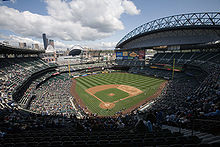
The Seattle Mariners have played their home games at T-Mobile Park since it opened in 1999.
The Seattle Mariners are a Major League Baseball (MLB) team based in Seattle, Washington, United States. The team has been a member of the American League's West division since they entered as an expansion franchise in 1977. Their name was chosen in a public contest and reflects the city's nautical history and location on Puget Sound. The team's first home stadium was the Kingdome, an indoor multi-purpose stadium shared with other sports, from 1977 until 1999. The Mariners moved to their current home, T-Mobile Park (formerly Safeco Field), when it opened on July 15, 1999; the stadium has a retractable roof and a seating capacity of 47,943.
The first MLB team in the Pacific Northwest, the Seattle Pilots, played for one season in 1969 as an American League expansion team at Sick's Stadium, a former minor league venue. After their sale to avoid bankruptcy, the Pilots moved to Milwaukee in 1970 and became the Brewers. The governments of Seattle, King County, and Washington filed a lawsuit against the American League in 1975 for a breach of contract in breaking the lease at Sick's Stadium; the lawsuit was withdrawn in exchange for a team that would play at the new Kingdome. After failed attempts to relocate an existing team, an expansion franchise was granted in 1976. (Full article...) -
Image 2The 1971 Cy Young Award won by Ferguson Jenkins, on display in the Canadian Baseball Hall of Fame
The Cy Young Award is given annually to the best pitchers in Major League Baseball (MLB), one each for the American League (AL) and National League (NL). The award was introduced in 1956 by Baseball Commissioner Ford C. Frick in honor of Hall of Fame pitcher Cy Young, who died in 1955. The award was originally given to the single best pitcher in the major leagues, but in 1967, after the retirement of Frick, the award was given to one pitcher in each league.
Each league's award is voted on by members of the Baseball Writers' Association of America (BBWAA). Local BBWAA chapter chairmen in each MLB city recommend two writers to vote for each award. Final approval comes from the BBWAA national secretrary-treasurer. Writers vote for either the American League or National League awards, depending on the league in which their local team plays. A total of 30 writers vote for each league's awards. Writers cast their votes prior to the start of postseason play. (Full article...) -
Image 3
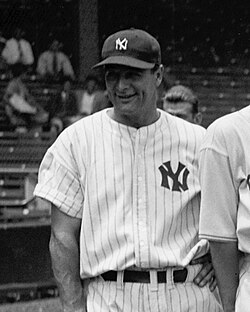
Lou Gehrig briefly held the single-season RBI record with his 175 in 1927 before Hack Wilson topped this total with 191 in 1930. In total Gehrig was responsible for three of the nine seasons in which a player hit 170 or more RBI.
In baseball, a run batted in (RBI) is awarded to a batter for each runner who scores as a result of the batter's action, including a hit, fielder's choice, sacrifice fly, bases loaded walk, or hit by pitch. A batter is also awarded an RBI for scoring himself upon hitting a home run. However, if a run scores because of an error that the defense commits on a batted ball, the batter does not (in most cases) receive an RBI; the exception is when the official scorer deems the run would've scored with or without an error, such as when an error occurs on a fielder's choice.
In Major League Baseball (MLB), a player in each league[L] wins the "RBI crown" or "RBI title" each season by hitting the most runs batted in that year. The first RBI champion in the National League (NL) was Deacon White; in the league's inaugural 1876 season, White hit 60 RBIs for the Chicago White Stockings. The American League (AL) was established in 1901, and Hall of Fame second baseman Nap Lajoie led that league with 125 RBIs for the Philadelphia Athletics. Over the course of his 27-season career, Cap Anson led the NL in RBI eight times. Babe Ruth and Honus Wagner have the second- and third-most RBI titles, respectively: Ruth with six, and Wagner with five. Several players are tied for the most consecutive seasons led with three: Anson (twice), Ty Cobb, Rogers Hornsby, Ruth, Joe Medwick, George Foster, and Cecil Fielder. Notably, Matt Holliday won the NL title in 2007 by one RBI over Ryan Howard, only overtaking Howard due to his performance in the 2007 National League Wild Card tie-breaker game. Had Howard won the 2007 title, he would have led the NL in a record four consecutive seasons from 2006 to 2009. The most recent champions are Kyle Tucker in the American League, and Matt Olson in the National League. (Full article...) -
Image 4The Hutch Award is given annually to an active Major League Baseball (MLB) player who "best exemplifies the fighting spirit and competitive desire" of Fred Hutchinson, by persevering through adversity. The award was created in 1965 in honor of Hutchinson, the former MLB pitcher and manager, who died of lung cancer the previous year. The Hutch Award was created by Hutch's longtime friends Bob Prince, a broadcaster for the Pittsburgh Pirates and KDKA; Jim Enright, a Chicago sportswriter; and Ritter Collett, the sports editor of the Dayton Journal Herald. They also created a scholarship fund for medical students engaged in cancer research to honor Hutchinson's memory.
Eleven members of the National Baseball Hall of Fame have won the Hutch Award. The inaugural winner was Mickey Mantle. Danny Thompson, the 1974 recipient, was diagnosed with leukemia earlier that year. He continued to play through the 1976 season before dying that December at the age of 29. Jon Lester won the award in 2008 after recovering from anaplastic large-cell lymphoma. (Full article...) -
Image 5The Commissioner's Historic Achievement Award is awarded by the commissioner of baseball, the chief executive of Major League Baseball (MLB), to a group or person who has made a "major impact on the sport" of baseball. It is not an annual award; rather, the Commissioner presents it at his discretion. The trophy is a gold baseball sitting atop a cylindrical silver base, created by Tiffany & Co. The award has been presented sixteen times: thirteen times to players, once to a team, and twice to a non-player. Mark McGwire and Sammy Sosa were the first to receive the award for their parts in the 1998 MLB home run record chase. The most recent recipient is Shohei Ohtani, who was honored in 2021 for being the first player in MLB history to be an All-Star as both a starting pitcher and a lead-off hitter in the 2021 All-Star Game and for completing a two-way season as a hitter and as a pitcher. The 2001 Seattle Mariners won the award as a team for posting a 116–46 record. Roberto Clemente, the 2006 awardee, is the only player to receive the award posthumously; his award was accepted by his wife, Vera.
Three years after McGwire and Sosa were honored, Cal Ripken Jr. and Tony Gwynn, both of whom retired after the 2001 season, received the award and were honored at the 2001 MLB All-Star Game; Ripken was elected to the American League All-Star team as a starter at third base, while Gwynn was later added as an honorary member of the National League team. During the first inning of the game, Alex Rodriguez, who had been elected the starter at shortstop—the position at which Ripken played for most of his career—switched positions with Ripken for the first inning of the game as a tribute. Including the presentation of the award to the Mariners following the season, the 2001 season's three awards are the most presented in a single year. (Full article...) -
Image 6

Eddie Guardado, a pitcher for the 1993 Xpress, was called up after 10 starts to make his MLB debut with the Minnesota Twins on June 13, 1993.
The Nashville Xpress Minor League Baseball team played two seasons in Nashville, Tennessee, from 1993 to 1994 as the Double-A affiliate of the Minnesota Twins. In those seasons, a total of 60 players competed in at least one game for the Xpress. The 1993 roster included a total of 35 players, while 38 played for the team in 1994. There were 13 players who were members of the team in both seasons. Of the 60 all-time Xpress players, 22 also played in at least one game for a Major League Baseball (MLB) team during their careers.
After the 1992 baseball season, Charlotte, North Carolina, home of the Double-A Southern League's Charlotte Knights, acquired a Triple-A expansion team in the International League, leaving the Southern League franchise in need of a new home. Larry Schmittou, president of the Triple-A Nashville Sounds, offered Herschel Greer Stadium as a temporary home for the displaced team until owner George Shinn could find a permanent home for his club. Upon the league's approval, the franchise relocated to Nashville and became the Nashville Xpress. In order to accommodate two teams at Greer, the Xpress' games were scheduled for during the Sounds' road trips. (Full article...) -
Image 7

Roy Halladay made his second consecutive Opening Day start for the Phillies in 2011 against the Houston Astros.
The Philadelphia Phillies are a Major League Baseball franchise based in Philadelphia. They play in the National League East division. Also known in early franchise history as the "Philadelphia Quakers", the Phillies have used 72 different Opening Day starting pitchers in their 128 seasons. The first game of the new baseball season for a team is played on Opening Day, and being named the Opening Day starter is an honor, which is often given to the player who is expected to lead the pitching staff that season, though there are various strategic reasons why a team's best pitcher might not start on Opening Day. Where decisions are known, the 72 starters have a combined Opening Day record of 33 wins, 40 losses and 20 no decisions (33–40–20); where decisions are unknown, the team's record was 17–19. No decisions are awarded to the starting pitcher if the game is won or lost after the starting pitcher has left the game. It can also result if a starting pitcher does not pitch five full innings, even if his team retains the lead and wins.
Hall of Fame left-handed pitcher Steve Carlton has the most Opening Day starts for the Phillies, with 14, compiling a record of 3–9–2. He is followed by Robin Roberts (twelve starts; 5–6–1), Chris Short (six starts; 3–1–2), and Curt Schilling (five starts; 2–0–3). Grover Cleveland Alexander also made five Opening Day starts for the Phillies, equal to Schilling; however, no information on his decisions in those games is available. The team's record in his five Opening Day starts is 4–1. (Full article...) -
Image 8In its 108-year history, the Minnesota Twins baseball franchise of Major League Baseball's American League has employed 31 managers. The duties of the manager include team strategy and leadership on and off the field. Eight of these team managers have been "player-managers", all during the Washington Senators era; specifically, they managed the team while still playing for it.
The Minnesota franchise began its life as the Washington Senators in Washington, D. C., where they played from their inception in 1901 to 1960. In the early twentieth century, the Senators were managed consecutively by three future members of the National Baseball Hall of Fame, bookended by Bucky Harris, who managed the team from 1924 to 1928 and again from 1935 to 1942. Walter Johnson managed the team for four seasons from 1929 to 1932, and he was followed by Joe Cronin, who led for the next two seasons (1933–1934). In 1960, the American League awarded an expansion franchise to Minneapolis, Minnesota; however, owner Calvin Griffith moved his team to Minnesota, and Washington was awarded the expansion team instead. Thus, the Minnesota Twins began play at Metropolitan Stadium in Bloomington, Minnesota the following year, during the tenure of manager Cookie Lavagetto, and played at the Hubert H. Humphrey Metrodome in downtown Minneapolis from 1982 to 2009. Under manager Ron Gardenhire, the team moved to Target Field beginning in the 2010 season. (Full article...) -
Image 9The St. Louis Cardinals, a professional baseball franchise based in St. Louis, Missouri, compete in the National League (NL) of Major League Baseball (MLB). Founded in 1882 as a charter member of the American Association (AA), the team was originally named the Brown Stockings before it was shortened to Browns the next season. The team moved to the National League in 1892 when the AA folded. The club changed its name to the Perfectos for one season in 1899 and adopted the Cardinals name in 1900. The St. Louis Cardinals are tied with the Cincinnati Reds and Pittsburgh Pirates as the third-oldest continuously operated baseball team.[a] In that time, the team has won 19 National League pennants and 11 World Series championships (most in the National League and second only to the New York Yankees, who have won 27). They also won four American Association pennants and one pre-World Series championship that Major League Baseball does not consider official.
The Cardinals had six periods of continued success during their history. The first period occurred during the 1880s when the team won four consecutive American Association pennants from 1885–1888 while known as the Browns. The Cardinals next found success from 1926–1934 when they played in five World Series, winning three. During World War II the Cardinals won four NL pennants in five years from 1942–1946, including three World Series championships. During the 1960s the Cardinals won two World Series and played in another. In the 1980s the Cardinals played in three World Series, winning in 1982. Most recently, the Cardinals have made the playoffs nine times, winning seven NL Central titles and qualifying as a wild-card entrant in 2001, 2011 and 2012, winning the World Series in 2006 and 2011. (Full article...) -
Image 10

Babe Ruth was the first player to reach 500 home runs and set a career home run mark of 714 that stood until 1974.
In Major League Baseball (MLB), the 500 home run club is a group of batters who have hit 500 or more regular-season home runs in their careers. There are twenty-eight players who are members of the 500 home run club. Seven 500 home run club members—Hank Aaron, Willie Mays, Eddie Murray, Rafael Palmeiro, Albert Pujols, Alex Rodriguez and Miguel Cabrera—are also members of the 3,000 hit club.
In the past, membership in the 500 home run club was a guarantee of eventual entry into the Baseball Hall of Fame, although some believe the milestone has become less meaningful in recent years and many members have not been enshrined in Cooperstown. (Full article...) -
Image 11
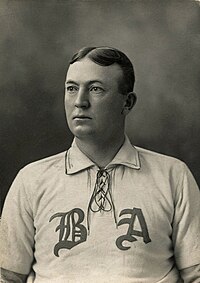
Cy Young is the all-time leader in wins.
In Major League Baseball, the 300-win club is the group of pitchers who have won 300 or more games. Twenty-four pitchers have reached this milestone. This list does not include Bobby Mathews who won 297 in the major leagues plus several more in 1869 and 1870 before the major leagues were established in 1871. The San Francisco Giants are the only franchise to see four players reach 300 wins while on their roster: Tim Keefe in the Players' League, Christy Mathewson and Mickey Welch while the team was in New York, and most recently Randy Johnson. Early in the history of professional baseball, many of the rules favored the pitcher over the batter; the distance pitchers threw to home plate was shorter than today, and pitchers were able to use foreign substances to alter the direction of the ball. Moreover, a schedule with rest days after most games allowed pitchers to start a far higher proportion of their team's games than modern pitchers do, typically every other game or even more (in the second half of the 1884 season Old Hoss Radbourn started 40 games out of 43). The first player to win 300 games was Pud Galvin in 1888. Seven pitchers recorded all or the majority of their career wins in the 19th century: Galvin, Cy Young, Kid Nichols, Keefe, John Clarkson, Charles Radbourn, and Welch. Four more pitchers joined the club in the first quarter of the 20th century: Mathewson, Walter Johnson, Eddie Plank, and Grover Cleveland Alexander. Young is the all-time leader in wins with 511, a mark that is considered unbreakable. If a modern-day pitcher won 20 games per season for 25 seasons, he would still be 11 games short of Young's mark.
Only three pitchers—Lefty Grove, Warren Spahn, and Early Wynn—joined the 300-win club between 1924 and 1982, which may be explained by a number of factors: the abolition of the spitball; World War II military service, such as Bob Feller's; and the growing importance of the home run in the game. As the home run became commonplace, the physical and mental demands on pitchers dramatically increased, which led to the use of a four-man starting rotation. Between 1982 and 1990, the 300-win club gained six members: Gaylord Perry, Phil Niekro, Steve Carlton, Nolan Ryan, Don Sutton, and Tom Seaver. These pitchers benefited from baseball's increase from a 154-game schedule to a 162-game schedule in 1961, and expansion of the league from 16 teams in 1960 to 26 by 1977. The increased use of specialized relief pitchers, an expanded strike zone, and new stadiums, including Shea Stadium, Dodger Stadium and the Astrodome, that were pitcher's parks all also suppressed offensive production. Also, the increasing sophistication of training methods and sports medicine - such as Tommy John surgery - allowed players to maintain a high competitive level for a longer time. Randy Johnson, for example, won more games in his 40s than he did in his 20s. (Full article...) -
Image 12

The Philadelphia Phillies won their second consecutive pennant in 2009 and lost to the San Francisco Giants in the 2010 NLCS.
The National League pennant winner of a given Major League Baseball season is the team that wins the championship—the pennant—of MLB's National League (NL). This team receives the Warren C. Giles Trophy and the right to play in the World Series against the champion of the American League (AL). The current NL pennant winners are the Los Angeles Dodgers, who beat out the New York Mets to win the NL pennant in October 2024.
The trophy is named for Warren Giles, the league president from 1951 to 1969, and is presented immediately after each NL Championship Series (NLCS) by Warren's son Bill Giles, the honorary league president and former owner of the Philadelphia Phillies. (Full article...) -
Image 13
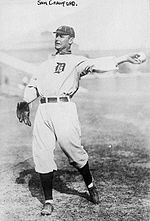
Sam Crawford retired in 1917 with 309 triples, the major league record.
In baseball, a triple is a hit in which the batter advances to third base in one play, with neither the benefit of a fielding error nor another runner being put out on a fielder's choice. Triples were more common in baseball's dead-ball era, when teams relied more on stolen bases and hit and run plays than on the home run. More distant fences in old ballparks, such as Pittsburgh's Forbes Field and Detroit's Tiger Stadium, also produced fewer home runs and more triples on well-hit balls. As a result, most of the players on this list have been retired for decades. Only two players in the top 50 all-time career triples leaders played after WWII (Stan Musial and Roberto Clemente), and there are no players in the top 50 who played after 1972.
In 2006, the Hardball Times lamented the decline of the 100-triple player, although three have joined the list since that time. Fangraphs, a statistical website, likewise noted the lack of modern 100-triple hitters in 2013. Of the 162 Major League Baseball players who have hit 100 or more triples, 69 are members of Baseball's Hall of Fame. (Full article...) -
Image 14

Tim Lincecum (2006) won two Cy Young Awards with the Giants.
The San Francisco Giants are a Major League Baseball (MLB) franchise based in San Francisco, California. They play in the National League West division. Officially known as the "First-Year Player Draft", the Rule 4 Draft is MLB's primary mechanism for assigning players from high schools, colleges, and other amateur clubs to its franchises. The draft order is determined based on the previous season's standings, with the team possessing the worst record receiving the first pick. In addition, teams which lost free agents in the previous off-season may be awarded compensatory or supplementary picks. Since the establishment of the draft in 1965, the Giants have selected 70 players in the first round.
Of those 70 players, 32 have been pitchers, the most of any position; 23 of these were right-handed, while 9 were left-handed. The Giants have also selected thirteen outfielders, seven shortstops, seven catchers, four third basemen, and three players each at first and second base. One player, 2010 selection Gary Brown, was drafted as a center fielder. The franchise has drafted eight players from colleges or high schools in their home state of California, more than any other. The Giants have never held the first-overall pick, but they did have the second pick in 1985, with which they drafted Will Clark. (Full article...) -
Image 15

Jimmy Nelson won the PCL Pitcher of the Year Award and was selected for the Triple-A All-Star Game in 2014.
The Nashville Sounds Minor League Baseball team has played in Nashville, Tennessee, since being established in 1978 as an expansion team of the Double-A Southern League (SL). They moved up to Triple-A in 1985 as members of the American Association (AA) before joining the Pacific Coast League (PCL) in 1998. The team was placed in the Triple-A East in 2021 prior to this becoming the International League in 2022. In the history of the franchise, numerous teams, players, and personnel have won awards, been selected for All-Star teams, or led their league in various statistical areas.
Three Sounds have won league Most Valuable Player (MVP) awards: Steve Balboni, Brian Dayett, and Magglio Ordóñez. Twelve have won Pitcher of the Year awards: Bruce Berenyi, Geoff Combe, Andy McGaffigan, Jamie Werly, Stefan Wever, Chris Hammond, Scott Ruffcorn, R. A. Dickey, Johnny Hellweg, Jimmy Nelson, Robert Gasser, and Chad Patrick. Two have won Rookie of the Year awards: Jeff Abbott and Magglio Ordóñez. Five managers have won Manager of the Year awards: Stump Merrill, Rick Renick, Frank Kremblas, Steve Scarsone, and Rick Sweet. Ordóñez won the 1997 AA MVP Award as well as the Rookie of the Year Award, making him the only Nashville player to win two year-end league awards for the same season. The only other team personnel to win multiple league awards, though in separate seasons, are Renick, who won the AA Manager of the Year Award in 1993 and 1996, President Larry Schmittou, who won the SL Executive of the Year Award in 1978 and the AA Executive of the Year Award in 1987 and 1989, and radio broadcaster Bob Jamison, who was named the SL Broadcaster of the Year in 1980 and 1982. The franchise was recognized with the Minor League Baseball Organization of the Year Award in 2022. The team won the Larry MacPhail Award in 1978, 1980, and 1981. Two managers have won the Mike Coolbaugh Award: Mike Guerrero and Rick Sweet. Thirty Sounds have been selected by their Major League Baseball organization for player or pitcher of the year awards. (Full article...)
More did you know
- ... that Irv Hall's 1,904 at bats without a home run from 1943 to 1946 places him second among batters since 1900 who never hit a home run during their Major League Baseball career?
- ... that the "Wizard of Oz" and "Iron Man" are just two of the eight members of the Baseball Hall of Fame who have won Gold Glove Awards at shortstop?
- ... that John Mayberry, Jr. hit his first two career home runs against the New York Yankees and the Toronto Blue Jays, the last two Major League Baseball teams for which his father John Mayberry played?
- ... that despite its author keeping detailed journals of his experiences, the baseball memoir Odd Man Out was criticized by many people named in the book as being factually inaccurate?
- ... that Nemo Gaines is the only graduate of the United States Naval Academy to play in Major League Baseball?
Sports portals
Selected picture

| Credit: American Tobacco Company |
Johannes Peter "Honus" Wagner (/ˈhɒnəs ˈwæɡnər/; February 24, 1874 – December 6, 1955), nicknamed The Flying Dutchman due to his superb speed and German heritage, was an American Major League Baseball shortstop who played in the National League from 1897 to 1917, almost entirely for the Pittsburgh Pirates. Wagner won eight batting titles, tied for the most in NL history with Tony Gwynn.
Associated Wikimedia
The following Wikimedia Foundation sister projects provide more on this subject:
-
Commons
Free media repository -
Wikibooks
Free textbooks and manuals -
Wikidata
Free knowledge base -
Wikinews
Free-content news -
Wikiquote
Collection of quotations -
Wikisource
Free-content library -
Wikiversity
Free learning tools -
Wiktionary
Dictionary and thesaurus
More portals
- Portals with triaged subpages from June 2018
- All portals with triaged subpages
- Portals with no named maintainer
- Automated article-slideshow portals with 51–100 articles in article list
- Automated article-slideshow portals with 501–1000 articles in article list
- Random portal component with 41–50 available subpages
- Automated article-slideshow portals with 201–500 articles in article list
- Random portal component with 11–15 available subpages
- Random portal component with 21–25 available image subpages

